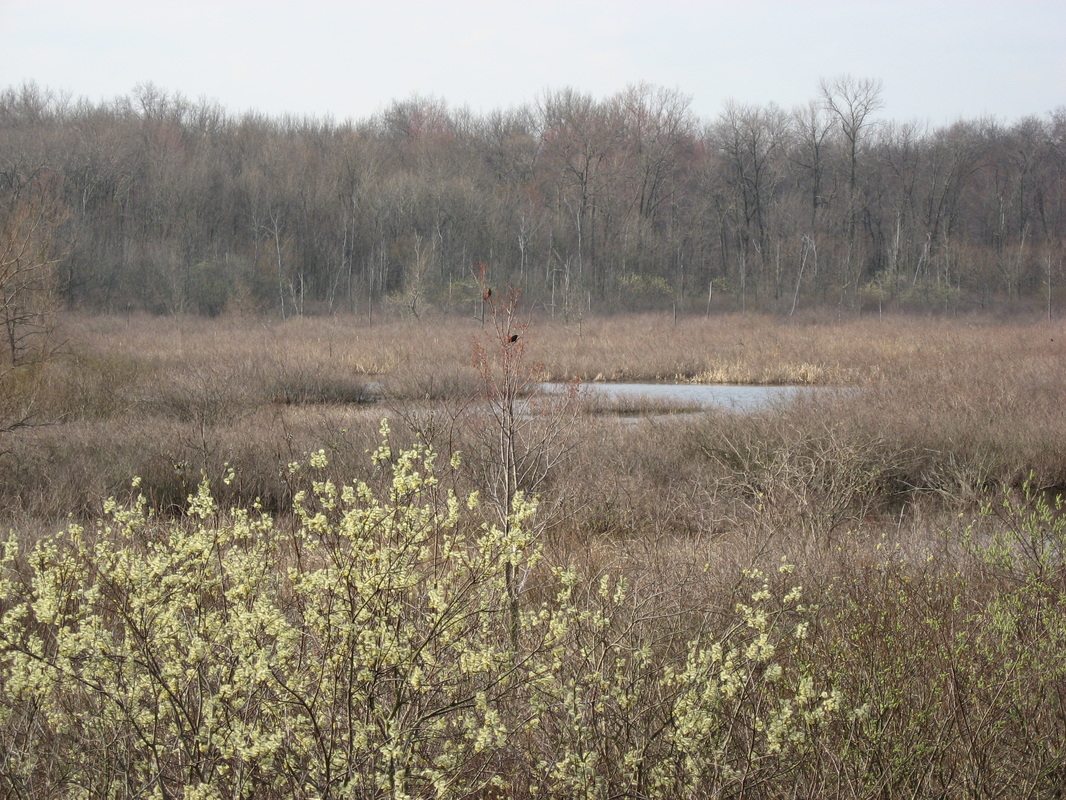with excitement at surviving my first night camping alone in a tent on a campsite in the Indiana Dunes National Lakeshore. My icy fingers balled into fists and stuffed in the warm pockets of a sweatshirt, I stood on the boardwalk overlooking the marsh and listened to the chattering of birds perched on branches touched by the first blushes of spring. I thought my heart would burst with joy at the intimacy I felt to nature, to all hints of life stretching before me. That first hike on my trek up the eastern coast of Lake Michigan was made in ecological ignorance. I did not realize there are different types of sand dunes, each formed by the powerful forces of wind, water, and the glaciers of the past. The Indiana Dunes are considered linear dunes, formed from the irregular cycles of high and low water levels. Defined by wet marshlands and long, parallel ridges of sand, the dunes are located in overlapping ecological transition zones. As a result, the area is a resting spot for over 350 species of migrating birds, and home to 1,135 different native plants and a rich assortment of other wildlife. As I began hiking into the forested mountains of sand, the seeds of passion began sprouting with each step, each new sighting of spring. And passion, for me, is synonymous to protecting. I suspect the same was true for Henry Cowles, a botanist from the University of Chicago. Publishing an article in 1886 entitled "Ecological Relations of the Vegetation on Sand Dunes of Lake Michigan," Cowles established himself as the "father of plant ecology." His research sparked a battle to protect the Indiana Dunes from development, from the removal of sand for manufacturing, from the industrialization that was occurring forty miles to the west. For while Cowles was bringing attention to the biodiversity of the dunes, John D. Rockefeller and Elbert Gary were building the infrastructures of oil refineries and steel mills, respectively, on the southwestern corner of Lake Michigan. Shunned by Chicago’s city fathers who wanted to keep the waterfront free from manufacturing, Rockefeller and Gary located their facilities in northern Indiana, creating thousands of jobs while providing kerosene, gas, and steel to the rapidly growing city of Chicago. At the end of that April day, I remember standing on top of Mt. Tom, a dune towering almost 200 feet high in the Indiana Dunes State Park. Filling my lungs with the cool breeze off the lake, I turned my gaze west, hoping to see the first splashes of sunset. Instead, I saw the smokestacks of Gary, Indiana and a sad outrage replaced my bliss. Decisions made over one hundred years ago shaped my view of the landscape in all directions. I turned my back on northwest Indiana. What I did not know was that under the leadership of Lee Botts, because of her determination and passion, the water and air quality of northwestern Indiana has improved by almost ninety percent since 1990. By founding organizations like the Federation of Lake Michigan (now expanded to all five lakes and known as the Alliance for the Great Lakes), the Indiana Dunes Learning Center, and the Northwest Indiana Quality of Life Council, Lee found ways to create dialogue among diverse stakeholders, to broker paths through the minefields of polarity, to create a shared vision, and then find collaborative solutions to make it happen. One of the top priorities of this coalition of federal, state, and local organizations, business and union leaders, scientists, environmental groups, and private residents is restoring the Grand Calumet River. Pooling resources, they are cleaning up a river listed as one of the forty-three most toxic waterways in the 1987 Great Lakes Water Quality Agreement between the United States and Canada. The goal is to complete all requirements outlined in the agreement by 2019 so the river can be delisted. This feels nothing short of miraculous. But it is not a miracle. It is hard, expensive work. According to the agreement, delisting requires the removal of all Beneficial Use Impairments (BUI), “changes in the chemical, physical, or biological integrity of the Great Lakes system that are significant enough to cause impairment to designated users.” It sounds complicated but the fourteen impairments used to measure the quality of the water are fairly straightforward. The list includes: any restrictions on fish and wildlife consumption; tainting of fish and wildlife flavor; degradation of fish and wildlife populations; discovering fish tumors or other deformities; bird or animal deformities or other reproduction problems; degradation of benthos (flora and fauna found on the bottom of the body of water); restriction on dredging activities; eutrophication (a form of water pollution caused by chemical nutrients such as phosphorus or nitrogen flowing into the water) or undesirable algae; restrictions on drinking water consumption; beach closings; degradation of aesthetics; added costs to agriculture and industry; degradation of phytoplankton and zooplankton populations; and loss of fish and wildlife habitat. The Grand Calumet had more BUIs than any other waterway on the Great Lakes. Rather than turning my back on northwest Indiana, I want to learn more. Gary, Indiana is an example of what can happen when a diverse group of people in a seemingly impossible situation, decides to collaborate; chooses to blend passion with purpose so they can leave a clean, healthy, and economically vibrant place for future generations to call home. It is a story that needs to be told.
8 Comments
Lynn Smith
11/4/2015 09:42:47 am
Wow! Mary, you did it again: The combination of history and hope in one tidy package. I'm so thankful for your involvement....your passion for protection!
Reply
Barb Ferguson
11/4/2015 10:05:06 am
Thanks for another thoughtful and informative post. I keep considering your phrase "passion and collaboration are two sides of the same coin".
Reply
Mary Ellen Miller
11/4/2015 10:32:31 am
Thanks are in order, Mary. To Lee Botts and to you. Thanks for taking up the cause of the hard, expensive work that has already been done, and forging it into the future. So much to be hopeful about!
Reply
Karen
11/4/2015 10:44:01 am
I've just been Mary McKScmidtified again.
Reply
Eric Stemle
11/5/2015 12:23:29 am
Mary, the comments above are a testament to the power and the beauty of your words. As I read your post, I marveled at so many lines and images that etched your message, and here they were again thanks to Lynn and Barb and Mary Ellen and Karen. If we are known for the company we keep, then you are truly blessed, my friend.
Reply
Pat Wisniewski
12/3/2015 07:29:50 pm
Thank you Mary for sharing the Shifting Sands documentary story and for you beautiful poetic writing about the the dunes and My friend and co-worker Lee Botts!
Reply
Jerilynn
12/5/2015 08:34:29 am
I'm so glad I finally got back to reading your blog.
Reply
Leave a Reply. |
From briefcase to pen, paper and camera, one woman's journey to influence
how we care for the environment, our seniors, each other. Available
from your local bookstore or online retailer 
The Ideal Gift Tiny Treasures, a collection of wildflower photographs and poetic prose, available by contacting me. The 2nd Edition of Tiny Treasures is designed for use on PCs, tablets, and phones and is available at online stores. To learn more, click on the Ibook/Ebook button below:
|





 RSS Feed
RSS Feed
